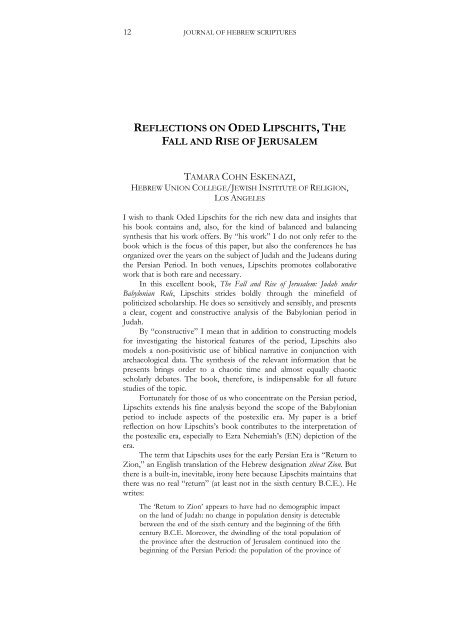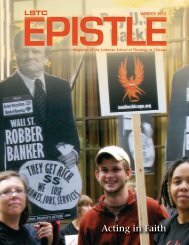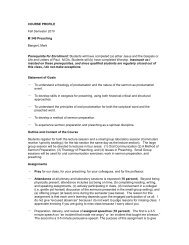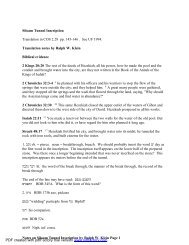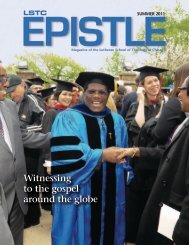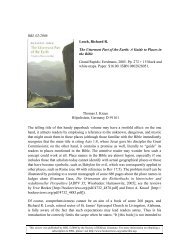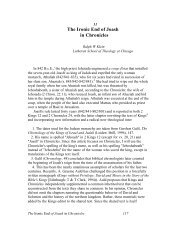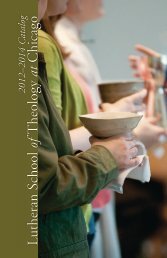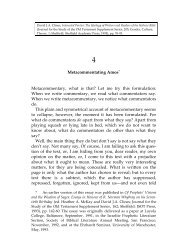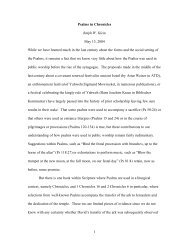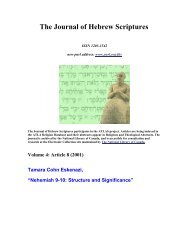12JOURNAL OF HEBREW SCRIPTURESREFLECTIONS ON ODED LIPSCHITS, THEFALL AND RISE OF JERUSALEMTAMARA COHN ESKENAZI,HEBREW UNION COLLEGE/JEWISH INSTITUTE OF RELIGION,LOS ANGELESI wish to thank Oded Lipschits for the rich new data and insights tha<strong>this</strong> book contains and, also, for the kind <strong>of</strong> balanced and balancingsynthesis that his work <strong>of</strong>fers. By “his work” I do not only refer to thebook which is the focus <strong>of</strong> <strong>this</strong> paper, but also the conferences he hasorganized over the years on the subject <strong>of</strong> Judah and the Judeans duringthe Persian Period. In both venues, Lipschits promotes collaborativework that is both rare and necessary.In <strong>this</strong> excellent book, The Fall and Rise <strong>of</strong> Jerusalem: Judah underBabylonian Rule, Lipschits strides boldly through the minefield <strong>of</strong>politicized scholarship. He does so sensitively and sensibly, and presentsa clear, cogent and constructive analysis <strong>of</strong> the Babylonian period inJudah.By “constructive” I mean that in addition to constructing modelsfor investigating the historical features <strong>of</strong> the period, Lipschits alsomodels a non-positivistic use <strong>of</strong> biblical narrative in conjunction witharchaeological data. The synthesis <strong>of</strong> the relevant information that hepresents brings order to a chaotic time and almost equally chaoticscholarly debates. The book, therefore, is indispensable for all futurestudies <strong>of</strong> the topic.Fortunately for those <strong>of</strong> us who concentrate on the Persian period,Lipschits extends his fine analysis beyond the scope <strong>of</strong> the Babylonianperiod to include aspects <strong>of</strong> the postexilic era. My paper is a briefreflection on how Lipschits’s book contributes to the interpretation <strong>of</strong>the postexilic era, especially to Ezra Nehemiah’s (EN) depiction <strong>of</strong> theera.The term that Lipschits uses for the early Persian Era is “Return toZion,” an English translation <strong>of</strong> the Hebrew designation shivat Zion. Butthere is a built-in, inevitable, irony here because Lipschits maintains thatthere was no real “return” (at least not in the sixth century B.C.E.). Hewrites:The ‘Return to Zion’ appears to have had no demographic impacton the land <strong>of</strong> Judah: no change in population density is detectablebetween the end <strong>of</strong> the sixth century and the beginning <strong>of</strong> the fifthcentury B.C.E. Moreover, the dwindling <strong>of</strong> the total population <strong>of</strong>the province after the destruction <strong>of</strong> Jerusalem continued into thebeginning <strong>of</strong> the Persian Period: the population <strong>of</strong> the province <strong>of</strong>
“IN CONVERSATION WITH ODED LIPSCHITS” 13Judah in the middle <strong>of</strong> the fifth century B.C.E. may be estimated atapproximately 30,000 people (Lipschits, 372).The estimated number for the province immediately after thedestruction <strong>of</strong> Jerusalem that Lipschits suggests is about 40,000.Lipschits supposes that at most several thousands <strong>of</strong> the nation’s elitereturned to Judah at the beginning <strong>of</strong> the Persian Period, but nothingmore. Jerusalem itself remained very poor.At first glance Lipschits’s picture <strong>of</strong> the period shatters that <strong>of</strong> EN.At a second glance, however, looked at critically, his work suggestsfresh ways for understanding aspects <strong>of</strong> EN in the context <strong>of</strong> the fifthcentury.In <strong>this</strong> short response to the book I will focus only on theinteresting light that Lipschits sheds on Ezra 1, a section that mostscholars consider as the latest section <strong>of</strong> EN, ever since H. G. M.Williamson’s influential article on the subject. 1 At a time when theconsensus tilts increasingly towards late (that is, Hellenistic) dating <strong>of</strong> all<strong>of</strong> EN, but especially Ezra 1-6, Lipschits’s analysis actually highlightsother possibilities.Although Lipschits himself does not say so, and may not evenagree with my conclusion, his works helps make sense <strong>of</strong> otherwisepuzzling details in Cyrus’s decree in Ezra 1:2-4 and in the narrator’ssummary <strong>of</strong> the response to it in 1:5-6.Let me begin with observations that Joseph Blenkinsopp made afew years ago, in two conferences organized by Lipschits (one in TelAviv and one in Heidelberg); the observations are now included in thepapers from the conferences. 2 Blenkinsopp has called attention to theimplicit hostilities between Judah and Benjamin that are reflected inbiblical texts. He examined texts that led him to conclude that suchhostility existed in the Neo-Babylonian and early Persian periods(Blenkinsopp, 2005, 624-643). According to Blenkinsopp, theassassination <strong>of</strong> Gedaliah “signaled the beginning <strong>of</strong> a period <strong>of</strong>Benjaminite-Judean hostility which continued throughout the firstcentury <strong>of</strong> Persian rule” (Blenkinsopp, 2005, 629). The probableexistence <strong>of</strong> a cult center in Bethel seems to be relevant in <strong>this</strong>connection. According to Blenkinsopp, Bethel remained a cult center –possibly the cult center – in the Neo-Babylonian period and into theearly Persian period. Its proximity to Mizpah, the administrative centerafter the fall <strong>of</strong> Jerusalem, enhanced its importance (Blenkinsopp, 2003,p. 99).The ways that Lipschits’s book highlights the reversal <strong>of</strong> fortune <strong>of</strong>these two areas – Judah and Benjamin – provide supportive evidence orreasons for <strong>this</strong> enmity. Combining literary sources and archaeologicaldata, Lipschits concludes that Mizpah in Benjamin was established as aBabylonian administrative center even before Jerusalem fell. On the eve1 33:1-30.“The Composition <strong>of</strong> Ezra i-iv,” JTS (1983)2 “Bethel in the Neo-Babylonian Period,” in Judah and the Judeans in the New-Babylonian Period, ed. O. Lipschits and J. Blenkinsopp (Eisenbrauns, 2003), 93-107, and “Benjamin Traditions Read in the Early Persian Period,” in Judah andthe Judeans in the Persian Period, ed. O. Lipschits and M. Oeming (Eisenbrauns,2005), 629-645.


